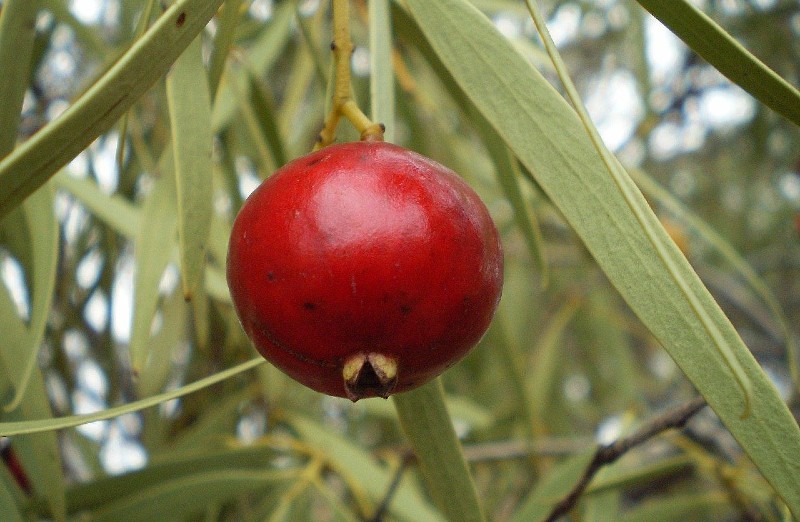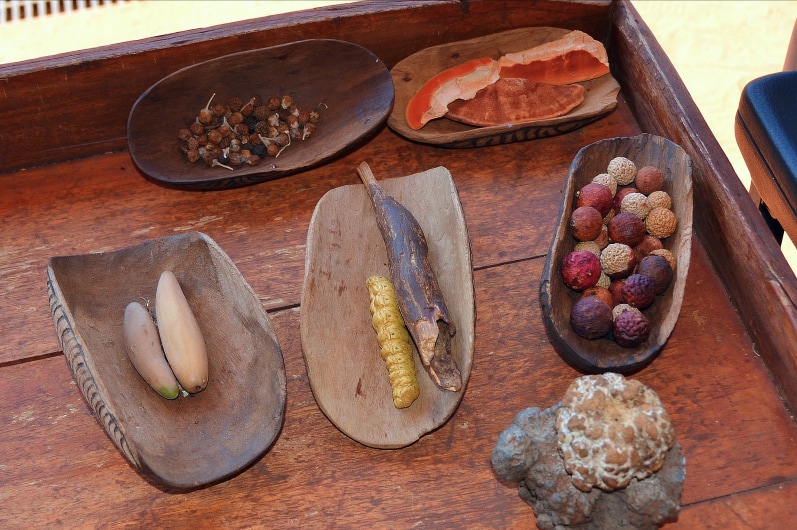Table of Contents
Australian bush food, colloquially and affectionately called “bush tucker”, refers to any food or ingredient native to the lands of Australia, be it flora or fauna. Much of Australia’s native bush foods were traditionally used by the Indigenous inhabitants as a source of nourishment during the hunter-gatherer days before the arrival of the colonial settlers. Indigenous tribes would live off the land, foraging for nutrient-rich and high-fiber ingredients such as native herbs, spices, fruit, seeds, and nuts. Animal sources of Australian bush tucker, such as kangaroo, emu, crocodile, and witchetty grubs, provided good protein. By necessity, the Indigenous Australians had extensive knowledge about the flora and fauna that surrounded them, and it was this knowledge that sustained them for tens of thousands of years.

Today, these native bush ingredients have seen a huge revival in everyday use, from gardening to culinary application to natural medicines and skincare. You’ll see tea tree and eucalyptus soaps used for their antibacterial properties, finger limes used in Michelin-starred kitchens, lemon myrtle used in body lotions, and kangaroo meat found in every supermarket. The land continues to provide. Come take a closer look at some of these native ingredients! Our beginner’s guide introduces you to a list of 10 Australian bush tucker foods to give you a better understanding of what the Indigenous people of Australia traditionally used as sustenance.
A brief history of Australian bush tucker
Aboriginal Australians have eaten native plant and animal foods for an estimated 60,000 years. The traditional methods used to process these foods evolved over time, with the toxicity of these ingredients playing a pivotal role in how bush tucker was prepared and consumed. As hunter-gatherers, they would look for energy-dense foods — foods that would provide necessary protein, fat, and sugar for survival in the harsh conditions of the bush. Often, these would include animal meat and offal, insects and grubs, and honey and fruit.
Most plant foods were eaten raw and meats were often cooked over hot campfire coals or wrapped in paperbark and baked in ground ovens. Overall, the bush tucker diet was one that provided high nutrition, offering good levels of protein, micronutrients, and fiber. Certain animal foods like witchetty grubs provided high-fat sources, but the majority of native land animals, including the kangaroo, provided very lean meat compared to many domesticated animals eaten today.
The colonization of Australia in 1788 greatly affected the traditional use of bush foods as native ingredients were deemed “less superior”. The introduction of non-native foods, coupled with the loss of traditional lands and destruction of native habitats, resulted in limited access to native foods and resources. Abandonment of native foods increasingly became the norm.
Recognition of Australia’s native bush foods grew in the 1970s. The 1980s brought kangaroo meat into the spotlight after it was made legal for consumption in South Australia. Native food crops like the highly-prized macadamias saw commercial levels of cultivation. Fast forward to today and previously-overlooked native foods are now being celebrated for their nutritional benefits and gourmet value across the country in award-winning restaurants and home kitchens.
A note on toxicity
The Indigenous people held a great deal of knowledge of their environment, evident in the way they carefully used the plants and animals around them. They came to understand which plants were dangerous to consume, which would work well in medicines, and what processes needed to be undertaken in order to make foods edible instead of toxic. This was done through many generations of trial and error.
If you plan to forage for bush tucker out in the wild, it is important to heed the warning of toxicity in plants. Many species can be difficult to identify. You should never eat any part of a wild-growing plant unless you are a hundred percent sure what it is.
Native Australian bush tucker foods
Desert quandong
Habitat: Desert quandong are widely found in arid and semi-arid regions of South Australia and the central deserts.
Don’t confuse yourself here! There are three types of quandong fruit found in Australia: the desert quandong, bitter quandong, and blue quandong. Only the desert quandong (Santalum acuminatum), sometimes referred to as the sweet quandong and desert peach, is considered palatable enough to eat and be commercially produced. Easily identified by its shiny red fruit, the trees carry cream-colored flowers and favor arid conditions. Belonging to the same family that includes sandalwood and native cherries, the desert quandong is considered a hemiparasitic plant, meaning it relies on host plants for water and nutrients.
The desert quandong was an important food source for Australian Aboriginals for thousands of years and the fruit was also used by early European settlers to make jams, jellies, and pies. Desert quandong can be eaten fresh or dried, with dried fruit prized for its ability to be kept for long periods of time — up to eight years! The kernels inside the fruit are also edible and were often used for medicinal purposes. The taste of the dry-textured fruit has been described as slightly sour and salty, with a similar profile to beans or dry lentils with earthy notes. The sweetness of the fruit is hard to determine and can vary greatly between trees. They have a much higher antioxidant capacity than blueberries and are comparable to avocados as a source of vitamin E making them a formidable superfood!
Bunya nut
Habitat: Bunya pine trees are found naturally in South East Queensland and in Queensland’s World Heritage-listed Wet Tropics to the north.
Imagine giant pine cones bigger than your head falling from massive trees that existed in the Jurassic period. Imagine cracking one of these cones open to find dozens of edible “nuts” inside. These supersized pine cones, believed to have been consumed whole by dinosaurs, exist in the real world. And they’re as cool as they sound.
Say hello to the bunya cone. They can weigh up to a whopping 18 kilograms and contain up to 100 large kernels (“nuts”). They come from bunya pine trees (Aracauria bidwilli), which are considered living fossils. Their cones were a very important food source for the Indigenous tribes who lived in Queensland. Aboriginal families would own a group of bunya trees and pass them down from generation to generation. Large harvest festivals would be held during the cone-fall season every two to seven years, and diverse tribes would set aside differences and gather in the Bon-yi Mountains (Bunya Mountains) to feast on these nuts. The nut can be eaten both cooked and raw, its flavor similar to chestnuts. Traditionally, they would be ground into a paste and then eaten directly, or cooked to make bread. They were also fermented and eaten as a delicacy.
Today, you can find bunya nuts sold in grocery stores around rural South East Queensland. Touted as a nutritious bush food, many home-invented recipes now exist for the bunya nut, including recipes for pancakes, bread, biscuits, and even tea.
Desert lime
Habitat: The desert lime is native to Queensland, New South Wales, and South Australia.
The desert lime (Citrus glauca) is one of several citrus species that can be found in Australia. The fruit can grow to the size of grapes, making them smaller than many other citrus fruits, though they certainly pack a powerful punch in the flavor department. The desert lime boasts an incredibly intense and zesty flavor and was often eaten whole by those living off the land. For many generations, the limes have been used to make flavorsome cordials, marmalades, sauces, pickles, and garnishes. Today, the desert lime is a highly-prized ingredient — you’ll find them infused in botanical spirits, dried and ground into flavored powders, and even used in anti-aging spa and facial treatments.
These little limes are a powerhouse of antioxidants and they contain three times more vitamin C than oranges, making them a healthy food source. Extremely versatile, the desert lime can be used in place of regular limes and lemons, but unlike its citrus cousins, desert limes require no peeling or preparation and can be eaten straight from the tree.
Finger lime
Habitat: Australian finger lime is most commonly found in the lowland subtropical rainforests of Queensland and New South Wales.
The finger lime (Citrus australasica) is also called “caviar lime” for a reason! Long in shape, much like a finger, this edible lime is filled with caviar-esque pearls that pop with an overwhelming flavor similar to that of regular round limes. The lime has made its way to many of Australia’s top restaurants, its beady pulp a unique, zesty, and attractive addition to dishes, desserts, and cocktails. But before its big debut in fancy restaurants, finger limes were an essential food source for Aboriginal Australians for thousands of years. Full of folate, vitamin E, vitamin C, and potassium, the lime has also been used as a topical treatment for many generations to treat infected sores.
Today, finger limes have gained so much of a reputation that many hobby gardeners have attempted to grow them at home. However, this is one of the most challenging citrus varieties to grow, having an extremely short season and growing only in specific climates. There’s a reason for that crazy price tag at farmers’ markets and restaurants!
Ruby saltbush
Habitat: Found in every state in Australia.
The ruby saltbush (Enchylaena tomentosa) is a semi-succulent native shrub that bears cylindrical leaves, hairy stems, and small, fleshy berries. The berries, which are edible, turn bright red or orange when ripe and have a crisp, salty-sweet flavor. They can be picked right off the plant and eaten raw, making them the ultimate snack food. In fact, they have provided a quick and convenient snack food for desert-dwelling Indigenous Australians for generations and the berries are still frequently collected today!
The berries can also be soaked in water to make a sweetened tea. Even the leaves are edible, though they are high in oxalates and need to be eaten sparingly or cooked before consumption. Tolerant to drought, the ruby saltbush is easy to find across both dryland and coastal parts of Australia, so keep a lookout for this low-growing shrub next time you’re out and about!
Lemon myrtle
Habitat: Native to the subtropical rainforests of central and southeastern Queensland.
Lemon myrtle (Backhousia citriodora) is known in culinary circles today for its clean, fresh, and defined lemony fragrance and flavor. Crush a few leaves and you’ll be greeted with the refreshing smell immediately. Its use dates back 40,000 years, with the Aboriginal Australians incorporating the plant in both cuisine and medicine. They would use lemon myrtle leaves to flavor fish dishes, wrapping them in paperbark parcels to seal in all the flavor while they cook in hot coals. They would also use crushed leaves to alleviate headaches by inhaling the scent.
On top of the plant’s high antioxidant content, the essential oil distilled from lemon myrtle has antimicrobial and antiseptic properties, which is why you’ll see many detergents, soaps, shampoos, cosmetics, and creams today featuring lemon myrtle essential oil.
Tasmanian pepperberry
Habitat: The Tasmanian pepperberry can be found in the cool and wet habitats of Tasmania’s alpine regions and the southeast mainland of Australia.
The Tasmanian pepperberry (Tasmannia lanceolata), or mountain pepper, is known for its peppery taste. But it’s not just the fleshy berries that produce this sharp flavor; the leaves of the plant, known for its biting, cinnamon-like taste, are also used in culinary preparations as a cooking spice to add depth and dimension to many dishes. The berries, when ground, make a great substitute for everyday pepper, with the added profile of boasting a more herbal, spicier, and hotter punch.
It has been well documented that the Indigenous population used this wonderful pepper through the ages as a flavoring agent in food, and also as a traditional medicine. They would crush the spice to form a paste and apply it to sore gums, toothaches, and other skin disorders. Early European settlers also took advantage of the plant’s antioxidant-rich properties, making tonics out of the ground bark, berries, and leaves to treat scurvy.
Today, pepperberries are used to flavor everything from cheeses to curries, and even alcoholic beverages.
Moreton Bay chestnut
Habitat: The Moreton Bay chestnut is native to the east coast, in particular Queensland and New South Wales. It is also naturally found on the Pacific islands of New Caledonia, Vanuatu, and the island of New Britain in Papua New Guinea.
The Moreton Bay chestnut (Castanospermum australe), sometimes referred to as “blackbean”, is an evergreen tree that can grow up to 40 meters tall. The tree produces bright red and yellow flowers and cylindrical pods that grow up to 20 centimeters long. The chestnut-like seeds inside the pods have been used as native Australian bush tucker for at least 2,500 years. However, there is a catch.
Unprocessed, the seeds cannot be eaten as they are toxic to humans. They must be carefully prepared to become edible. The Aboriginal people devised a way to leach the toxins out of the seeds. First, they would roast the seeds in a fire, then cut them up into smaller pieces and soak them in water for several days. Finally, they would pound the seeds into a flour, which was then mixed with water to make unleavened bread. A lengthy process, but ultimately one that allowed them to consume the seeds without harm. Today, Moreton Bay chestnuts are not widely used.
Bush coconut
Habitat: The bush coconut is a product of bloodwood eucalypt trees that grow in the deserts of Central Australia.
Believe it or not, the bush coconut is a combination of both an animal and a plant. Weird? I’ll explain. The bush coconut grows only on desert bloodwood eucalypt trees (Corymbia terminalis). They are formed as a result of a symbiotic relationship between the tree and an adult female scale insect. When the insect attaches itself to the tree, the tree activates a defense mechanism, growing a “gall” around it. Not that the insect minds at all, as it is perfectly content living and breeding in the tree this way.
The galls look like small, knobbly, woody fruit, and are able to grow as large as tennis balls. The galls were harvested by the Aranda people of Central Australia and eaten for the nutritious flesh inside. Galls were split open with a rock to access the white flesh, said to taste like coconut. Of course, nothing goes to waste — the insect inside the gall would also be eaten for its high water content and sweet taste.
Witchetty grub
Habitat: Widespread throughout the Northern Territory, and found in parts of South Australia and Western Australia.
Every Aussie has heard of the witchetty grub. Famous on the bush tucker menu, they are the quintessential staple of the Aboriginal Australians who lived in the desert. Even today, they are an important food for many who live out in the bush.
These large, worm-like creepy crawlies are actually white wood-eating moth larvae. They love feeding on the roots of the witchetty bush and the wood of black wattle trees, making them easy to snag. Often eaten raw or roasted in hot ashes, they are the most important high-protein insect food found in the desert. So, what exactly do they taste like? Surprisingly, when eaten raw, the liquid center of the witchetty grub tastes nutty and almond-like, and when cooked, its insides turn a light yellow and the outer skin becomes reminiscent of crisp roast chicken. Some say that cooked grubs taste like scrambled eggs, others are reminded of the flavor of popcorn. As far as bush foods go, that doesn’t sound bad at all!
We hope you had fun learning about these 10 incredible Australian bush tucker foods through our quick, introductory guide. Next time you find yourself outdoors, take a closer look at the flora and fauna of your surroundings. You might find yourself in the midst of some very special traditional ingredients that have been used for millennia!
Try some bush tucker for yourself
Looking for an easy way to try some Indigenous Australian bush tucker? Check out The Australian Superfood Co.! Together with growers and communities, they source an amazing variety of native seeds, fruits, herbs, and spices to create delicious products that celebrate Australia’s native ingredients.
About TourHero
TourHero is a social travel platform that enables you to travel with like-minded people and fall in love with the journey. We work closely with handpicked local operators to ensure every experience curated is unique and exclusive to your travel group. Come with us on epic adventures and create memories that last a lifetime!







